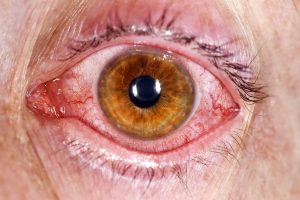10 acute conjunctivitis facts

In this article, we will describe 10 facts about acute conjunctivitis.
1. Definition
- Acute conjunctivitis, commonly known as ‘red or pink eye’, is an inflammation of the conjunctiva, the thin membrane covering the white part of the eye and the inner surface of the eyelids
- This condition is characterised by redness, itching, and discharge in the affected eye.
2. Causes
-
Viral infections (adenovirus, herpes simplex)
-
Bacterial infections (Staphylococcus aureus, Streptococcus pneumoniae)
-
Allergens (pollen, dust mites)
-
Irritants (chemicals, smoke).
3. Risk Factors
-
Close contact with an infected person. Viral and bacterial conjunctivitis are contagious
-
Poor hygiene
-
Sharing personal items
-
Allergies
-
Exposure to chemicals or irritants.
4. Who Gets It?
Anyone can develop acute conjunctivitis, but certain groups are more susceptible:
-
Children, especially in daycare or school settings
-
People with allergies
-
Individuals with compromised immune systems
-
Contact lens wearers.
Note. Conjunctivitis can be more serious in newborns – so seek medical attention if you suspect your baby has conjunctivitis.
5. Symptoms
-
Redness and inflammation
-
Itching, burning, or grittiness
-
Discharge or crusting
-
Vision may be a little blurred but after wiping away discharge, there is no visual loss
-
Sensitivity to light.
Note. Visual loss is an indication to see a doctor soon, as it may not be conjunctivitis.
6. Diagnosis
Diagnosis is typically a ‘clinical diagnosis’ (not tests required) based on:
-
Medical history
- Symptoms
- Physical examination
- Laboratory tests (swab or culture) may be performed to determine the underlying cause.
7. Treatment
Most patients can treat themselves, or go to a pharmacist initially. Then treatment depends on the cause:
-
Viral conjunctivitis: supportive care, antiviral medication (if herpes simplex)
-
Bacterial conjunctivitis: antibiotic eye drops or ointment – e.g. 1% chloramphenicol. You can get that from a pharmacy
-
Allergic conjunctivitis: antihistamine eye drops, avoidance of allergen
-
Irritant conjunctivitis: removal of irritant, supportive care.
8. When to see a doctor (Complications)
If left untreated, acute conjunctivitis can lead to:
- If does not improve in three days of self-treatment or from a pharmacy
-
Visual loss
-
Chronic or recurrent conjunctivitis
-
Corneal ulcers
-
Spread of infection to other parts of the eye.
9. Prevention (Lifestyle Changes)
-
Practice good hygiene (wash hands frequently)
-
Avoid sharing personal items
-
Avoid rubbing or touching eyes
-
Use clean contact lenses and storage cases. Do not share them
-
Avoid exposure to known allergens or irritants.
Contact lenses can exacerbate conjunctivitis – so avoid wearing them until symptoms have resolved.
10. Recurrence
Acute conjunctivitis can recur if:
-
Underlying cause is not fully treated
-
Allergens or irritants are not avoided
-
Hygiene practices are poor
-
Immune system is compromised.
Summary
We have described information 10 facts on acute conjunctivitis. We hope you understand it better now.

